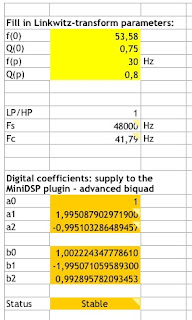SigmaStudio Tutorial Part 4.
This is a continuation of the previous part 3. A speaker with a closed design can be extended with EQ. It can be done by using the Automatic Speaker EQ block but using a Linkwitz transform is a bit more sophisticated. The filter can be used alone or in combination with other EQ filters. In this example I will use it to extend bass from 50 Hz down to 30 Hz. Note that a filter like the Linkwitz transform might require a lot of amplification and wattage. Make sure to keep it sane and make sure to protect your drivers from the most excessive displacements (e.g. use in combination with a low cut filter).
To extend the bass response with a Linkwitz transform we need to calculate the biquads needed for the DSP. I usually start with the VituixCAD Enclosure tool.
I will use the SB23NRXS45-8 in this example. I will use the entry in the VituixCAD built in database and a box volume of 32 liters. This is
what you get from VituixCAD Enclosure tool (info tab):
STATISTICS
f3 53.4 Hz
f6 41.2 Hz
f10 31.3 Hz
Zmin 5.6 Ohm @ 329.4 Hz
Zmax 59.9 Ohm @ 53.4 Hz
GDmax 5.1 ms @ 37.8 Hz
XmaxC 1.9 mm @ 5 Hz
Pmax 1.4 VA @ 329.4 Hz
-------------------------------------------------------------
DRIVER: SB Acoustics SB23NRXS45-8, 1 pcs in series
n0 0.44 % Reference efficiency
SPL 88.5 dB/W Sensitivity
USPL 90.1 dB/2.83 Sensitivity
EBP 65.9 Efficiency bandwidth product
Dd 16.6 cm Effective diameter of driver
Vd 140.4 cm^3 Maximum linear volume of displacement
Cas 6.65E-7 m^5/N Acoustic equivalent of Cms
Mas 5.25E1 kg/m^4 Acoustic equivalent of Mms+Mme
Ras 1.65E3 Ns/m^5 Acoustic equivalent of Rms
Rae 2.15E4 Ns/m^5 Acoustic equivalent of Re+Rg
-------------------------------------------------------------
BOX REAR 1: Vb=32.0 l, Ql=100.0
Fb 53.4 Hz System resonance frequency
Cab 2.27E-7 m^5/N Acoustic compliance of air in enclosure
Rab 4.38E2 Ns/m^5 Acoustic resistance due to absorption
Ral 1.31E6 Ns/m^5 Acoustic resistance due to leakage
Qtc 0.75 Total Q factor
Next stop is Rod Elliott's download area where you will find a Linkwitz transform calculator spreadsheet. Download, unzip and open the spreadsheet. Start on the "Box" tab and enter some T/S parameters (taken from the SB23NRXS45-8 entry in VituixCAD or the spec. sheet). Fs = 27 Hz, Qts = 0.38, Vas = -94 l and finally the box volume Vb = -32 l (the spreadsheet uses negative volume numbers to indicate liters instead of cu ft.). Now switch to the "Linkwitz Transform Calculator" tab and the only thing you have to enter is the f(p) and Q(p).
If I would try to extend all the way down to 20 Hz I would end up with a gain of around 17 dB. I think that is way too much, I would prefer no more than 10 dB. It would take me down to 30 Hz with a Q(p) of 0.80. Much better than the 53.4 without the Linkwitz transform.
SigmaStudio offers a load of generic filters but you will not find a Linkwitz transform. What you can do is to use a PEQ or a General (Second order) filter and set it to IIR Coefficient. So add a General (2nd order) block from the Filters ToolBox to your SigmaStudio project. Right-click the General (2nd order) filter -> Add Algorithm -> IC 1 -> 2 Channel Double Precision. Click the GUI button in the center of the filter block and select IIR Coefficient from the top drop-down list. You can then enter the b0, b1, b2, a1 and a2 values needed by the DSP to generate the Linkwitz transform.
But how on earth do you calculate the IIR Coefficient? Another spreadsheet to the rescue. Go to the miniDSP Linkwitz Transform page and download the Biquad calculation spreadsheet. Unzip and open up the spreadsheet. You now have to fill in the Linkwitz transform parameters and luckily we already got them from the Linkwitz transform calculator spreadsheet.
You will now have the digital coefficients used by miniDSP (based on your locale make sure the integer part is separated with a dot and not a comma like in my spreadsheets above). Make sure to multiply a1 and a2 with -1 before you input these parameters into SigmaStudio. You can now use the Simulation Stimuli and Probe in SigmaStudio to simulate the response.
Insert the new filter into your existing audio chain and your project should look something like this:
You now got the basis for a two way active filter using the DSP to also EQ the measured response between 50 Hz and 17 kHz. It then uses a Linkwitz transform to extend bass down to 30 Hz.
This was all done on the Main Schematic tab. It might be fine if the DSP is just going to be used as an active filter. A better way might be to put all speaker EQ on its own Hierarchy Board. You can create a new Hierarchy Board from the Systems Tool Box and name it Speaker EQ. You will loose all settings in the Automatic Speaker EQ blocks if you just cut and paste them from the Main board to the Speaker EQ board. You have to click the GUI button on each Automatic Speaker EQ block and select File -> Save from the dialogs top left menu. You can then use this file to load the settings into the empty block after it has been cut and pasted into the new Hierarchy Board. You also need to add Hierarchy Input and Output from the Systems ToolBox to the board, it might look something like this:
And the Main Schematic board might look something like this:













